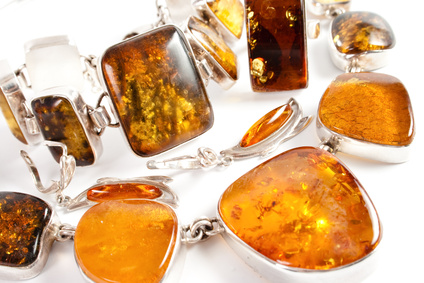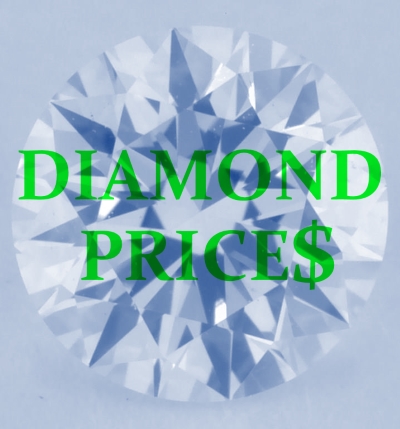The Structure of an Amethyst Gemstone
Amethyst is a variety of quartz and is made up of silicon dioxide. The purple color of this gemstone is caused by impurities present in its crystal structure.

Amethyst necklace
Amethyst’s hardness is rated 7 out of 10 on the Mohs scale, so the stone is relatively hard, although harder gemstones such as diamond or sapphire can scratch it.
Amethyst Value
Until the eighteenth century, amethyst held a high value because the gemstone was rare. Later, since an abundance of it was found in Brazil, the stone has been significantly devalued.
High-grade amethyst, also known as “Deep Russian,” still remains rare and holds significant value. Even the highest grade amethyst is not as expensive as a sapphire or ruby of similar quality.
Evaluating the Color of Amethyst

Amethyst gemstones
Amethyst comes in variations of violet.
The primary color of amethyst is purple, but it can have red and blue as secondary colors, which can range from very pronounced to virtually invisible.
Lighter stones have a pinkish hue, whereas darker ones have a deep purple tone.
In general, deeper colors are more desirable and command higher prices.
There is an amethyst color called “Deep Siberian,” which has an intense purple hue and is considered the best grade for amethyst.
When evaluating the color of amethyst, make sure to look at the gemstone in daylight so that you can perceive the stone’s hue most accurately.
Under artificial light, amethyst’s color may look less saturated, especially if the light is too intense. Look at the gemstone in a variety of settings so that you can get a feel for how its color changes in different lighting conditions.
Is There Green Amethyst?
Many people are led to believe that amethyst also has a green variety, but this is incorrect. What passes for green amethyst is simply green quartz.
It is true that amethyst is also a variety of quartz, but the green variety of this mineral is not technically considered amethyst. However, it is possible to turn amethyst green through heat treatment, but natural amethyst does not occur in this color.
Evaluating the Clarity of Amethyst
When evaluating gemstone characteristics, clarity is understood as the lack of visible defects inside the stone as well as on its surface. The internal imperfections (inclusions) should be as few and small as possible.
Look at the amethyst in a well-lit setting, and see if the stone looks clean to the naked eye. It is best to buy amethyst that is as clean as possible.
Evaluating the Cut of Amethyst
Colored gemstones such as amethyst are usually cut to maximize their color. There are not pre-set ideal proportions as is the case with diamonds, which are cut to maximize brilliance and sparkle.
So, when buying an amethyst, you should evaluate its cut indirectly by looking at how intense the stone’s color is. If the amethyst’s tone is well saturated and the gemstone is cut in a shape that you like, then the stone should be a good choice for you.
Treated Amethyst
Many amethyst stones are treated with heat to enhance the intensity of their color. Usually, the effects are permanent as long as the stone is not exposed to extreme heat.
However, when shopping, always ask whether the gemstone you are about to buy has been treated and how – it is always good to know such information.
It might be interesting for you to learn that although amethyst is purple in color, treatment with heat or irradiation can produce yellow, orange, and brown varieties.
This type of color-changing treatment is how amethyst can be turned into yellow citrine, which is also a variety of quarts.
Synthetic Amethyst
Synthetic amethyst is created in a lab under controlled conditions. The process usually involves taking clear quartz and irradiating it until its color becomes purple.
Stones produced this way are very similar to natural amethysts in terms of looks and physical properties. In fact, it is very hard to tell the difference without using special equipment since both natural and synthetic amethyst are a variety of quartz.
Wearing Amethyst Jewelry
Amethysts can be worn for any occasion. Whether as birthday or graduation gifts, amethysts are beautiful to behold and are more affordable than their sapphire counterparts.
This gemstone can complement any outfit and may be used for casual or more elegant wear.
Amethyst stones exhibit true beauty and flexibility, appearing expensive even though they are not.
Since amethysts are affordable, they can be worn with a variety of outfits. The stone’s purple color goes well with green, blue and yellow. A nice elegant white, green or blue gown can be beautifully complemented with an amethyst necklace, ring or bracelet.
Caring for Amethyst
Amethyst has no special care requirements. The gem can be washed with warm soap and water or jewelry cleaner.
Amethyst Beliefs
The amethyst has been the subject of many myths over the years. Not only is it the birthstone for those born in February, but it is also believed to have healing powers.
Amethyst is believed to increase nobility and spiritual awareness, and also to help communication. It belongs to the element of Air, and its name comes from the Greek word “amethystos”, which means “free from drunkenness.” As such, the stone was used as a hangover remedy.
It’s important to note that only natural amethysts are believed to hold any magical and healing properties.
Through history, the amethyst has been used as a talisman, and some believe that the stone is most active on Saturdays and Wednesdays.
Every culture has its own beliefs in what the purple-colored stone can do.
Fishermen and sailors have worn the amethyst for many years. The stone is seen as a protector because it is said to change colors in the event of frost and storms.
It is also said that it will provide protection against the natural disasters to all who choose to wear the stone.
The magic properties of the amethyst are strongest in February and March according to various beliefs. This means that it is easier to gain spiritual awareness, reach an internal balance and gain psychic abilities during these months.
The stone is also believed to have healing and cleansing powers. This is what led the Greeks to name it in honor of freeing them from drunkenness. It is believed that those who wear amethyst will experience a sobering effect on overindulging in addictions such as alcohol and drugs.














